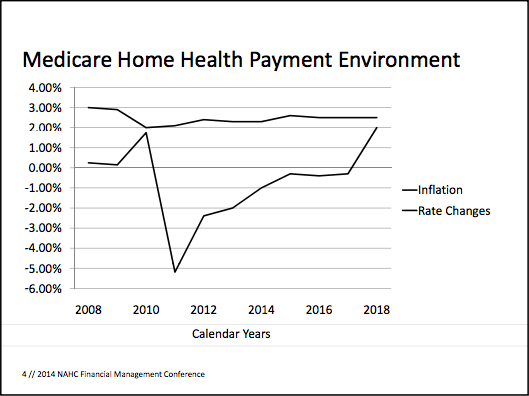In an industry rife with funding cuts, it will be sink or swim for home health and hospice providers who want to continue operating under thinning margins and rising regulations.
Those providers who can diversify their service offerings, however, can find the lifesaver they need to survive in the current Medicare home health environment marked by shrinking margins and greater regulatory burdens, said one expert Monday during the National Association for Home Care & Hospice (NAHC) Financial Management Conference in Chicago.
New rules regarding face-t0-face physician encounters, therapy assessments and hospice claims processing requirements have all driven the cost of doing business for home health care agencies, said Mark Sharp, partner at BKD, during a conference presentation.
An accounting and advisory firm headquartered in Springfield, Missouri, BKD works with a number of providers who are dealing with shrinking margins.
Given the fluctuation in recent years between the inflation rate and Medicare rate changes, there are disparities between the two.
In 2011, the home health industry saw a 5.2% decrease in base Medicare rates while inflation that year was a little over 2%, according to slide presentation provided by Sharp during the conference.

Despite the 7% gap between the inflation vs. decrease in payment rate during that timeframe, the difference didn’t hurt providers’ margins as logic would indicate.
“You’d think that would be a drop of 7% in your margin, however, agencies only saw about a 3% drop in margins,” Sharp said. “During a two-year period, rates were reduced 7% and we only lost about three points off our margins. The industry has done a good job of adjusting to stay alive, but the question is how long can you withstand that gap?”
One good strategy is through diversification, Sharp added, especially in an industry where there has been an over-reliance on Medicare.
“We’ve gotten drunk on Medicare,” he said, quoting the comment of an NAHC conference panelist in years past. “Reliance on one thing is very dangerous.”
Some strategies home health providers may undertake to diversify revenue streams include jumping into other business lines such as hospice, durable medical equipment, home infusion, or personal and private care, Sharp noted. Others might entail investing in telehealth platforms, medication management or even home modification platforms.
BKD has even seen hospice agencies add home health components to begin offering palliative care, as well as home health agencies offering outpatient therapy, which they may be able to bill out of Medicare Part B using their Part A provider number, Sharp said.
Risks apply, however, for agencies that might be overzealous in trying to grow their revenue sources.
“Providers can increase their economies of scale, but if it’s such a vertical move where you can’t share staff, then you might not be gaining as much,” he said.
Solely taking the cost containment route in looking at the parts of business where the agency can save more may not be enough in the long-run.
“You cannot simply cut your way out of financial difficulties. This will eventually become a death spiral for your agency,” states a Home Care & Hospice Financial Managers Association (HHFMA) White Paper on Cost Containment Practices released this week at the NAHC Chicago event. “You must look at ways to increase your revenues in order to get back to full health.”
Despite increasing regulatory burdens there are opportunities to grow for providers of all shapes and sizes. One of those areas happens to be within the Affordable Care Act, which contains provisions to bring more funding to home- and community-based services, Sharp said.
“There are so many programs that have yet to be brought out, we just have to keep out eyes and ears open,” Sharp said. “You can’t afford to not grow more and you can’t afford to not do it wisely.”
Written by Jason Oliva




